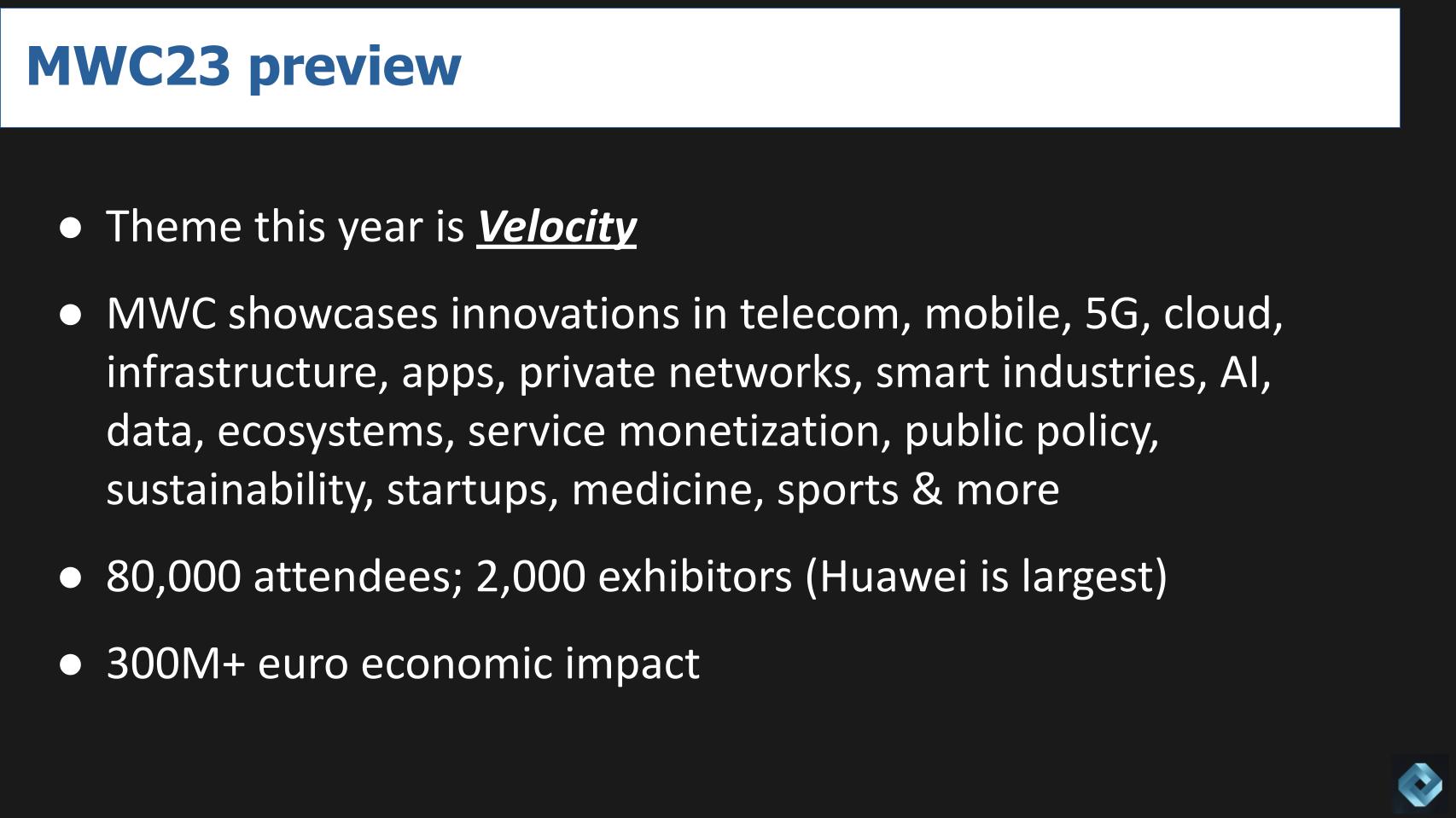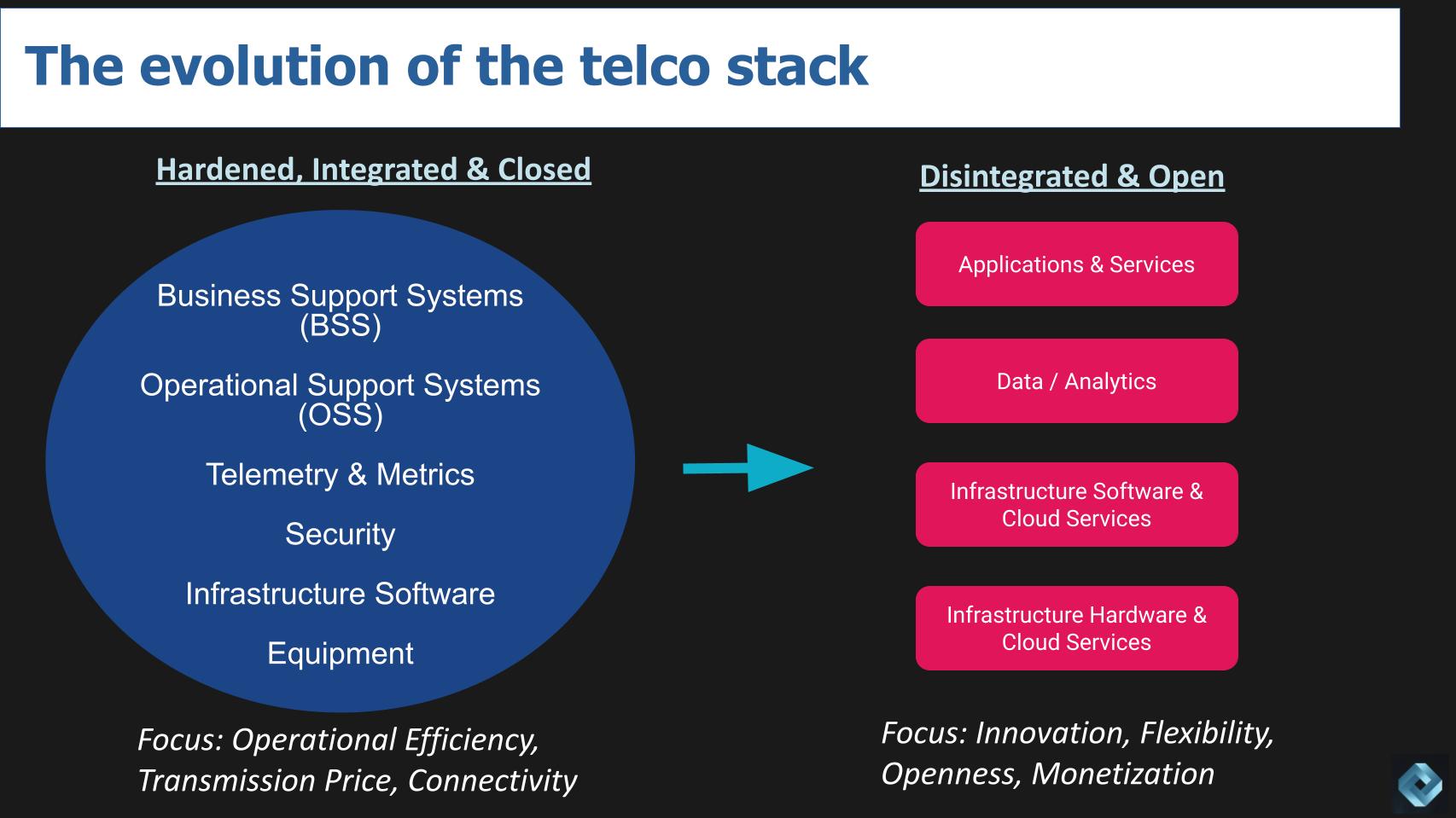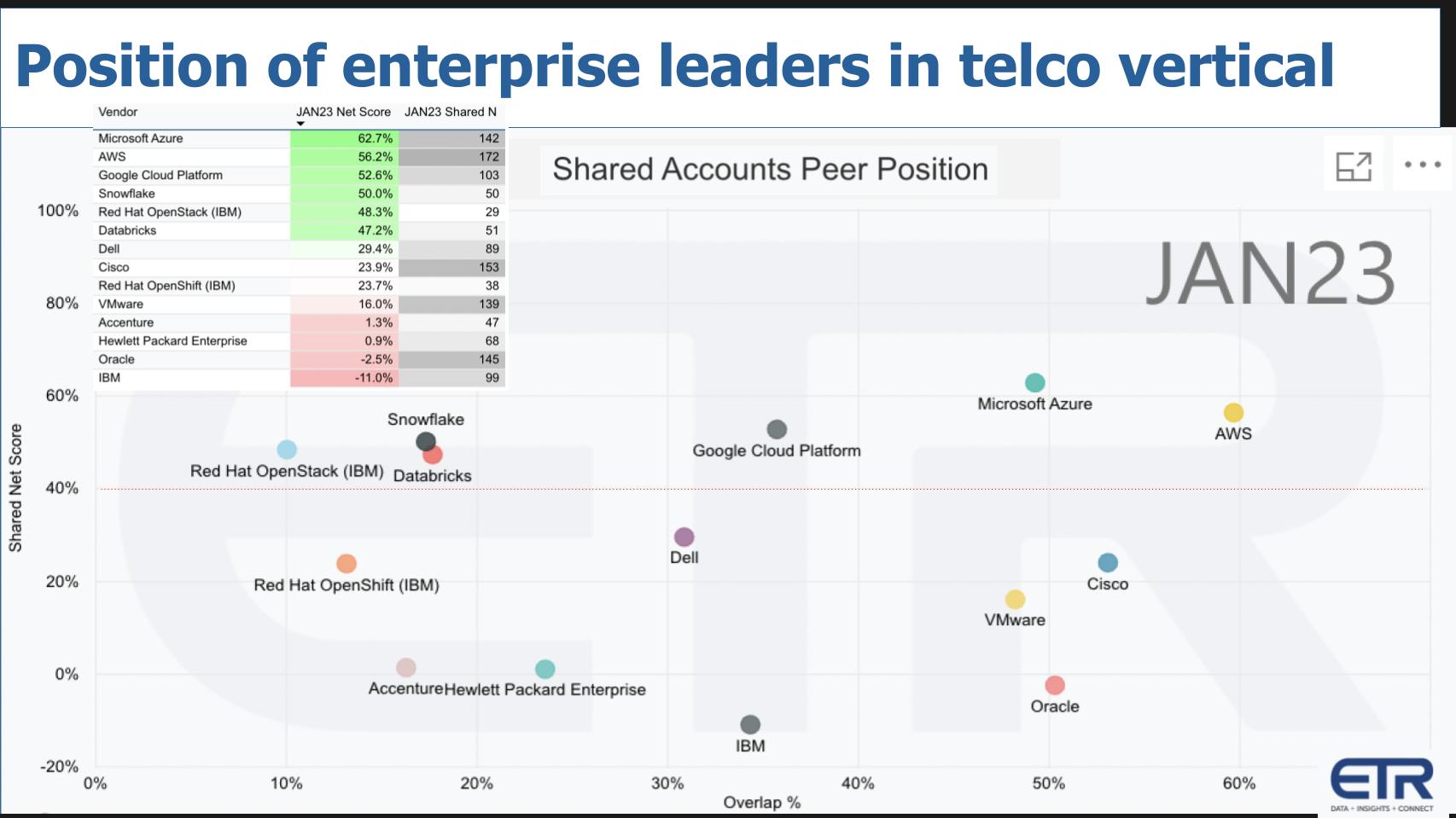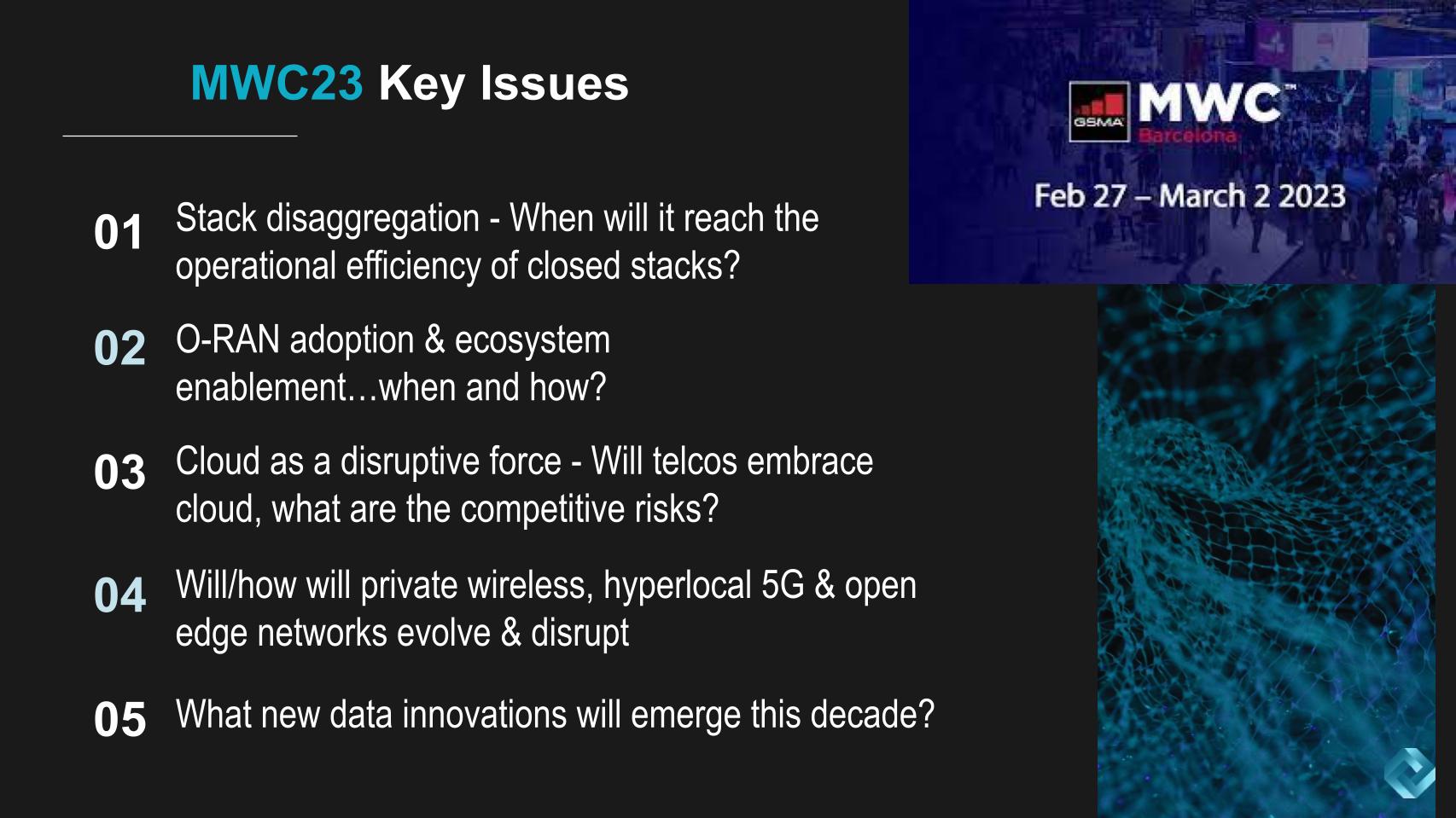The world’s leading telcos are often branded as monopolies that lack innovation. Telcos have been great at operational efficiency, connectivity and living off of transmission services. But in a world beyond telephone poles and basic wireless services, how will telcos modernize, become more agile and monetize new opportunities brought about by 5G, private wireless and a spate of new innovations in infrastructure, cloud, data, AI and apps? It’s become table stakes for carriers to evolve their hardened, proprietary infrastructure stacks to more open, flexible, cloud-like models. But doing so brings risks that telcos must carefully balance as they strive to deliver consistent quality of service while at the same time moving faster and avoiding disruption.
In this Breaking Analysis and ahead of MWC23, we explore the evolution of the telco business and how the industry is in many ways, mimicking a transformation that took place decades ago in enterprise IT. We’ll model some of the traditional enterprise vendors using ETR data and investigate how they’re faring in the telecomms vertical. And we’ll pose some of the key issues facing the industry this decade.
MWC23…Not Pre-COVID Attendance but Impressive
First let’s take a look at what the GSMA has in store for MWC23.

GSMA, the host of what used to be called Mobile World Congress, has set the theme for this year’s event as velocity. They’ve rebranded MWC to reflect the fact that mobile technology is only one part of the story. MWC has become one of the world’s premier tech events highlighting innovations not only in telco, mobile and 5G but the colliding forces of cloud, infrastructure, apps, private network, smart industries, machine intelligence/AI and more. MWC comprises an enormous ecosystem of service providers, technology companies, and firms from all industries, including sports and entertainment.
As well the GSMA along with its venue partner at the Fira Barcelona, have placed a major emphasis on sustainability and public/private partnerships. Virtually every industry will be represented at the event because every industry is impacted by the trends and opportunities in the communications space.
GSMA has said it expects 80,000 attendees at this year’s event – not back to 2019 levels but trending in that direction. Attendance by participants from China has historically been very high at the show and obviously the continued travel issues from that region are affecting the overall attendance. But still very strong. Despite these concerns, Huawei, the giant Chinese technology company, has the largest presence of any exhibitor at the show.
And finally, GSMA estimates that more than 300M Euro in economic benefit will result from the event which takes place at the end of February and early March in Barcelona.
The Evolution of the Stack – Building the Telco Cloud
The team from SiliconANGLE theCUBE will be back at MWC this year with a major presence thanks to our anchor sponsor, Dell Technologies and other supporters of our content program including EnterpriseWeb, Arrcus, VMware, Snowflake, Cisco, AWS and others.
At the heart of our ongoing research and reporting is the importance of leading carriers evolving their technology stacks. It’s a topic that’s often talked about and one that we observed took place in the 1990s when the vertically integrated IBM mainframe monopoly gave way to a disintegrated and horizontal industry structure.

In many ways the same thing is happening today in telecommunications shown on the left hand side of the above diagram. Historically, telcos have relied on a hardened, integrated and incredibly reliable and secure set of silicon, server hardware, metrics and software services that have been fully vetted, tested, certified and confidently deployed for decades.
And at the top of that stack on the left are the crown jewels, the operational support systems (OSS) and the business support systems (BSS). The OSS deals with network management, network operations, service delivery, QoS, fulfillment assurance and the like. The BSS systems look after the customer-facing elements of the stack like revenue, order management, product offerings, billing and customer service.
Historically telcos have been strong at operational efficiency and making money off of transport and connectivity. But they’ve lacked the innovation in services. They own the pipes and that works well. But others – e.g. over the top (OTT) content companies (Netflix, Amazon Prime, Hulu…) or private network providers and increasingly cloud providers – have been able to bypass the telcos to drive innovation and secure customer relationships (and data) directly.
As with enterprise IT, we’re seeing multiple models emerge including an embrace of the public cloud, but more often hybrid models that might selectively tap certain public cloud services but maintaining control of core systems in house.
The Horizontal Stack is Emerging
In the early part of last decade, network function virtualization (NFV) was touted by a number of vendors to solve the problem of inflexible telco infrastructure. NFV failed. It turned out to be complicated, too expensive and it got blindsided by the cloud operating model. Carriers were left with the choice of moving their stacks into the public cloud or doing their own time-consuming integration and testing to achieve a more flexible operating model.
The rightmost part of the diagram above conceptualizes where we think the industry is headed. It addresses the trend toward disaggregating key pieces of the stack. Within the bottom layer, silicon players are eyeing opportunities to disrupt the current market. And while the similarities to the 1990s in enterprise IT are greater than the differences, there are things that are new and silicon is a main area of focus. The enterprise stack disruption in the 1990’s was mainly driven by next generation CPUs (286, 386, Pentium, etc.). Today, vendors like Intel and AMD, who are critical get lots of attention. But increasingly, as we’ve previously reported in our Does Hardware Matter series, other supporting silicon components from firms like Broadcom and Qualcomm, as well as alternative processor vendors including Arm and Nvidia are innovating to drive the next wave of performance and cost efficiency.
Indeed many of the supporting components in new servers from the likes of Dell and HPE add as much value to customers as the microprocessor itself. This is directly due to the fact that the world is moving from a CPU-centric model to one that we’ve said is connect-centric. Meaning the components surrounding the core CPU are driving an increasing amount of value for customers.
Other differences are seen as you move up the stack. For example, the granularity of hardware infrastructure may not be as high as in the 1990’s high where competition occurred at every layer of the value chain with very little infrastructure integration. That of course changed in the 2010s with converged infrastructure and hyperconverged and software defined…so that’s different today.
As well, the advent of cloud, containers, microservices and AI…none of these were major factors in the disintegration of legacy IT. And that probably means that todays disruptors can move even faster than did Intel, Microsoft, Oracle, Cisco and Seagate in the 1990s.
In addition, while many of the products and services will come from traditional enterprise IT names like Dell, HPE, Cisco, Red Hat, VMware, AWS, Microsoft and Google…the names will also include different suppliers and come from traditional network equipment providers like Ericsson, Huawei and Nokia. And the partner ecosystem will be more diverse as well with other names like Wind River, Rakuten and Dish Network.
Enormous opportunities exist in data too. Telecom companies and their competitors must go beyond telemetry data into more advanced analytics and data monetization. There will also be an entirely new set of apps based on the workloads and use cases ranging from hospitals, sports arenas, race tracks, shipping ports, etc. You name it, virtually every vertical will participate in this transformation as the industry evolves its focus toward innovation, agility and open ecosystems.
Tug of War – Speed vs. Quality
Remember also this is not a binary state. There will be greenfield companies disrupting the apple cart but incumbent telcos will continue to ensure newer systems work with legacy infrastructure and, as we know, that’s not an overnight task. Which makes this all so interesting because of the friction between the need for speed juxtaposed with quality.
As such, telco equipment buyers will benefit from those providers that can help simplify integration with engineered systems, pre-packaged layers of the stack and lab certifications that go beyond reference models and actually guarantee the efficacy of SKUs that include ecosystem components.
How Enterprise Players Fare in Telecommunications Sectors
As stated, several traditional enterprise companies are or will be playing in this space. ETR doesn’t have a ton of data on specific telecom equipment and software providers but it does have some interesting data that we cut for this Breaking Analysis.

Above we show a graphic with some of the names that we’ve followed over the years in Breaking Analysis; and how they’re faring specifically within the telco sector.
The Y axis shows Net Score or spending velocity and the horizontal axis shows the presence or pervasiveness in the data set. The table insert in the upper left informs how the dots are plotted. And that red dotted line at 40% indicates a highly elevated level. Below we comment on some of the cohorts and share with you how they’re doing in telecommunications sector relative to their position overall.
Public Cloud Show Greater Momentum in Telco
Let’s start with the public cloud players. They’re prominent in every industry and an interesting group in telco. On the one hand they can help telecommunication firms modernize and become more agile by eliminating heavy lifting, data center costs and all the cloud benefits. At the same time, public cloud players are bringing their services to the edge, building out their own global networks and are a disruptive force to traditional telcos. The following summarizes the position of hyperscalers relative to their average Net Score in the ETR data set:
- Azure’s Net Score is basically identical in telco relative to its average;
- AWS’ Net Score is higher in telco by around three (3) percentage points;
- Google Cloud Platform is eight (8) percentage points higher in telco with a 53% Net Score.
So all three hyperscalers have an equal or stronger presence in telco than their average.
Next let’s look at the traditional enterprise hardware and software infrastructure cohort. Dell, Cisco, HPE, Red Hat, VMware, Oracle.
- Dell’s Net Score is ten (10) percentage points higher in telco than its overall average.;
- Cisco’s Net Score is only slightly higher in telco;
- HPE’s Net Score is actually lower by about nine (9) percentage points; and
- VMware’s Net Score is lower by four (4) percentage points in telco.
Red Hat is interesting. OpenStack as we’ve previously reported is popular with telcos wanting to build out their own private cloud and the data shows:
- Red Hat OpenStack’s Net Score is fifteen (15) percentage points higher in telco than its overall average;
- Red Hat’s OpenShift on the other hand has a Net Score that’s four (4) percentage points lower in telco than its overall average.
Oracle’s spending momentum is somewhat lower in the sector than its average despite the firm having a decent telco business. IBM and Accenture are both meaningfully lower in the sector than their average overall.
We’ve also highlighted two data platform players Snowflake and Databricks:
- Snowflake’s Net Score is much lower in telco, by about twelve (12) percentage points relative to its very high average Net Score of 62.3% overall. We believe however that Snowflake will be player in this space as telcos need to modernize their analytics stack and share data in a governed manner;
- Databricks’ Net Score is also much lower than its average by about thirteen (13) points.
Both companies are superglued to the cloud and so their fortunes in telco should follow a similar adoption curve but based on what we shared above regarding public cloud there seems to be some catching up to do for these firms. It’s likely because they both play further up the stack and that will take more time.
Key Issues to Explore at MWC 2023

Let’s close out on what we’re going to be talking about at MWC 2023 on theCUBE and some of the key issues we’ll be unpacking.
Stack Disaggregation
We’ve talked about stack disaggregation today but the key here will be the pace at which it will reach the operational efficiency and reliability of closed stacks. Telcos are engineering-heavy firms and much of their work takes place in the “basements” of their firms. They tend to move slowly and cautiously. While they understand the importance of agility telcos will be careful because that’s in their DNA. At the same time if they don’t move fast enough they will get hurt.
So that will be a topic of conversation and we’ll be looking for proof points. The other comment we’ll add is around integration. Telcos, because of their conservatism, will benefit from better testing and those firms that can innovate on the testing front with labs and certifications for their ecosystems will be in a better position. Open sometimes means wild west so the more players like Dell, HPE, Cisco, Red Hat etc. that offer integration capabilities out of the box, the faster adoption will go.
OpenRAN & the Ecosystem
O-RAN, or open radio access networks, allow operators to more easily mix and match RAN subcomponents from different vendors and innovate faster. O-RAN is an emerging network architecture that enables the use of open technologies from an ecosystem. Over time, almost all RAN will likely be open, but questions remain as to when the industry will be able to deliver the operational efficiency of traditional RAN. Rakuten, for example, is a company with an emphasis on improving the operational efficiency of OpenRAN. Dish Network is also embracing O-RAN but coming at if from more of a service innovation angle. So we’ll test this assertion and investigate where the various models on the spectrum fit.
Cloud as a Telco Enabler & Disruptor
On the one hand cloud can help drive agility, optionality and innovation for incumbent telcos…but the flip side is it can do the same for startups trying to disrupt. And while some telcos are embracing the cloud, many are being cautious. So that’s going to be an interesting topic of discussion.
Hyperlocal Private Networks
Private wireless networks, 5G, Wi-Fi 6 and local private networks are being deployed and this trend will accelerate. The importance here is that the use cases will be widely varied. The needs of a hospital will be different than those of a sports venue or a remote drilling site or a concert venue. Private networks will utilize spectrum across a range of frequencies and are beholden to a variety of local laws and licensing restrictions. New technologies and spectrum utilization choices are emerging to facilitate faster adoption. We’ll be probing for the rate this will occur.
Data, AI, Ethics, Privacy & Compliance
As always we’ll be looking at the data angles. It’s in theCUBE’s DNA to follow the data to understand the opportunities, risks, challenges and technologies that drive data value. Real time AI inference at the edge and changing data flows will bring new services and monetization opportunities. With the advent of private networks, many firms will be bypassing traditional telecommunications carriers to build these out to gain proprietary access to customer relationships and data.
How will this disrupt industries and incumbents? What risks are involved in terms of ethics, privacy, governance and the like and which players will emerge as winners.
Visit theCUBE at Stand CS 60
The news organization at SiliconANGLE and theCUBE broadcast team will be on location at MWC 2023 at the end of this month with a great set. We’re in the walkway between Halls 4 and 5 right in Congress Square. We have a full schedule with a great lineup so if you have editorial ideas, news stories, customers that want to share their stories don’t hesitate to reach out.
See you in person or online.
Keep in Touch
Many thanks to Alex Myerson and Ken Shifman on production, podcasts and media workflows for Breaking Analysis. Special thanks to Kristen Martin and Cheryl Knight who help us keep our community informed and get the word out. And to Rob Hof, our EiC at SiliconANGLE.
Remember we publish each week on Wikibon and SiliconANGLE. These episodes are all available as podcasts wherever you listen.
Email david.vellante@siliconangle.com | DM @dvellante on Twitter | Comment on our LinkedIn posts.
Also, check out this ETR Tutorial we created, which explains the spending methodology in more detail.
Watch the full video analysis:
All statements made regarding companies or securities are strictly beliefs, points of view and opinions held by SiliconANGLE Media, Enterprise Technology Research, other guests on theCUBE and guest writers. Such statements are not recommendations by these individuals to buy, sell or hold any security. The content presented does not constitute investment advice and should not be used as the basis for any investment decision. You and only you are responsible for your investment decisions.
Disclosure: Many of the companies cited in Breaking Analysis are sponsors of theCUBE and/or clients of Wikibon. None of these firms or other companies have any editorial control over or advanced viewing of what’s published in Breaking Analysis.



